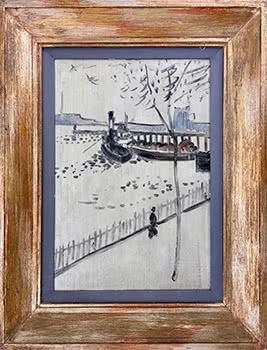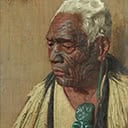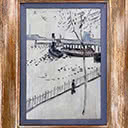Cremorne Wharf
30 x 21 cm
est. $20,000 - 30,000
Provenance:
Acquired directly from the artist.
Major Frederick Charnley, MC,
Indian Army, RWF, RA, RE
who lived in Chelsea, London at the time when McIntyre was painting there. Charnley family collection, UK
Raymond McIntyre arrived in London in 1909 and soon after set out to investigate art schools with the intention of furthering his studies. This was his primary reason for coming to London. In London has all the confidence and informal character of en plein air sketching which the Barbizon school and then the impressionists - for whom working in natural light became particularly important - had made so influential from the mid-19th century.
Following the direction of Les Nabis (1888-1896), who had in turn built upon the example of Cézanne and the encouragement of Gauguin, McIntyre arrived at the point where linear perspective and modelling almost disappear; and a flattened, decorative surface of grid-lines and colour planes emerges.
McIntyre left New Zealand to immerse himself in the influence and stimulus of European art and he would have probably, modestly, admitted that his work became, to use his own words, more interesting viewed from the standpoint of modern artistic developments in Europe as a result.
Raymond McIntyre (1879 - 1933) was an emigre New Zealand artist whose departure was an enormous loss to painting in this country. Born in Christchurch he studied with Petrus van der Velden and attended evening classes organised by the Canterbury College School of Art. In 1905 he joined a sketch club where he met Sydney Lough Thompson who had recently returned from four years study in Europe. From 1906 -1908 McIntyre shared a studio in Cathedral Square with Leonard Booth who described him as an enthusiastic disciple of Whistler.
In 1906 -1907 McIntyre was able to observe for himself the new techniques of impressionism when twenty works by English Art Club members were shown at the New Zealand International Exhibition in Christchurch.
These were to be enormously influential in forming McIntyre's modern style of painting, a factor which did not always endear him to the art establishment in New Zealand. Consequently, in 1909 at the age of thirty, he left for England where he began an intensive period of study with such noted artists as Walter Sickert and William Nicholson.
Diverse work included street scenes, a subject he shared with the Camden Town Group, and from 1920 he began to paint rivers and parks. McIntyre was also a talented musician, writer, printmaker, theatre and music critic. For some years he was art critic for Architectural Review. He was a Christian Scientist from 1907 and in 1933 refused an operation for a hernia. The resulting infection caused his death which could have been prevented if he had permitted medical treatment.





